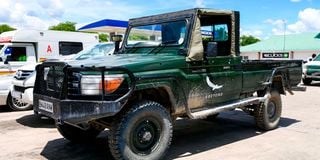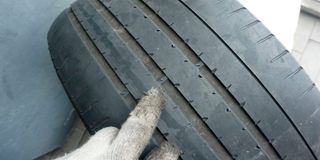Premium
Which off-roaders are most suitable for Kenya’s roads?

Toyota Land Cruiser 70 series is tried and tested.
Gavin,
I am an ardent reader of the DN2 Motor Clinic and would really like you to discuss the best off-roaders suitable for Kenya’s road conditions.
Regards,
Samuel
You rightly recognise that vehicles designed for and even extensively used off-road still do much of their motoring on-road – both tarmac highways and (in Kenya) on dirt tracks that can be rocky, swampy, bumpy and sometimes severely disfigured. Extensive on-road use disqualifies highly specialised expedition vehicles (as used in the Rhino Charge, for example) and fully fledged off-road use disqualifies any 4WD vehicle that doesn’t have a chassis, big wheels and high ground clearance (SUVs, for example). It also crosses out vehicles that are very capable of driving off-road, but low-profile tyres and luxury paraphernalia make them unlikely to ever go bundu bashing (Chelsea Tractors, for example).
That still leaves a huge range of choice from many major manufacturers and independent specialists. None of them is simply “the best”. Each has different strengths and necessary compromises, depending on different design priorities of power, strength, agility, speed, space, size, capacity, comfort, price, running economy, durability, reliability, fixability…
Those with exceptional technical respect and granted iconic status include the military Hummer (not the civilian clone), the Toyota Mega Cruiser (military version not permitted), the Jeep (the original MB3 and the CJ5); the Land-Rover (and independent upgrades like the Bola), the Range-Rover (the Classic, especially its 3.5 litre V8 engine), Mercedes Gelanderwagen (aka Peugeot P3), Mitsubishi’s Pajero/Shogun (and their Paris-Dakar cousins), endless Fords (especially the 150 and 250 series)…there are dozens of brands and hundreds of model options.
But if there was a worldwide referendum on this subject, the winner – by a very big margin – would be the Toyota Land-Cruiser, especially any model or modification based on the 70s series pick-ups. These are capable and durable, simple and fixable, powerful and (relatively) affordable. They have been global best-sellers for decades. Though rivalled by the Ford 150 (by dint of sheer single market size), even Americans, who are no strangers to MAG jingoism, would vote for it…with their wallets. Check the used car prices of Fords and Toyotas in the US.
The Land-Cruiser 70s, with 4.2 litre straight-six diesel engines, have been put to every imaginable use and converted to every conceivable purpose, just about everywhere, from equatorial deserts to arctic tundra, on ranches, farms and building sites, as mobile workshops and ambulances, as machine-gun platforms on battle fields, as tour buses and hunting wagons, as breakdown trucks and family shopping cars, by power company field teams and the police, as RVs and boat launchers…
They are recognised and respected as the ultimate workhorse. In extraordinarily harsh conditions and over exceptionally high mileages. Of course the Land-Cruiser is not the “best” at anything. There are others that are faster or bigger or more agile or whatever, but the 70s series isn’t about or, or, or. It is about and, and, and!

All four tyres of a car suffer some scrubbing and flexing all the time, but incur very little wear when driving in a straight line at moderate speed.
Do you rotate your tyres during every service?
Gavin,
I got a flat tyre and went to have it changed at a nearby petrol station. The problem was two nails that had punctured the wheel. The tyre was repaired and was as good as new. Meanwhile, the attendant pointed out that the front tyres were worn out and advised me to swap them with the ones at the back, which were in better condition. What advantage is there to have less worn out front tyres? And why do front tyres wear out faster than rear tyres?
Njambi
Short answer: Front tyres wear out faster because in normal motoring they do a lot more work – in particular, they do the steering and they handle about 70 percent of the braking forces, and they are more prone to misalignment. On front-wheel drive cars, they also transmit the power for acceleration. It is especially important that front tyres are in good condition because they are more essential to control the vehicle – an accident is much more likely if front tyres are sub-standard or fail than if a rear tyre malfunction.
Longer answer: Tyres are worn out by friction and heat. The primary causes of those are the “scrubbing” action of acceleration, braking, cornering and rough surfaces and the “flexing” action of overloading, under-inflation and sustained high speed. Tyres with softer rubber compounds, low=ply sidewalls and/or chunky treads wear more rapidly.
All four tyres of a car suffer some scrubbing and flexing all the time, but incur very little wear when driving in a straight line at moderate speed. As described, front tyres take the brunt of braking, steering and inertial weight shifts. All of the forces that cause scrubbing and flexing and resultant heat are least when driving style is gradual and gentle, and greatest when changes in pace or direction are sudden and harsh.
If one of your tyres (front or back) is wearing faster than the others, or unevenly, check the suspension geometry. If both front tyres are wearing unevenly, check the wheel/steering alignment. If two of your tyres are well worn, certainly it is less dangerous to fit them on the back but that doesn’t make you safe. All four tyres should be in good condition.
In some markets, you can use a puncture repair to get you to the end of your journey but are then required to replace the tyre with new. And all four should have identical specifications and similar levels of wear. That is extreme pedantry, but technically correct. To keep tyres in symmetrical condition, good practice is to rotate them at every service so they all (including the spare) spend about equal time in each corner (and in the boot) during their wear life.

The weight vehicles are licensed to carry should be related to their engine size.
How fast should trucks move?
Gavin,
I ask this out of concern since I drive daily. What should be the open-road cruising speed of a truck which is designed for the job it is doing, is in good condition, is properly loaded, and proficiently driven?
Cornelius.
Happily, there is a clear and quite precise answer on tens of thousands of arterial highways used by many millions of trucks throughout the world every day. It’s between 80 and 100kph. And every manufacturer ensures regular haulage trucks are designed to do that.
Not in the middle of towns. Not where the road is exceptionally narrow, or twisty or rough, and for very large trucks, not always where there are steep hills. But always and everywhere when the road is broad enough, smooth enough and flat enough. In places with functional traffic systems, trucks of all sizes are part of the ambient traffic flow.
The universality of this answer begs another question: why do so many of the very big trucks in Kenya, and even a high proportion of smaller ones, have an apparent cruising speed of 50kph (and often less) on the broadest, smoothest and flattest roads we’ve got? Are they being put to work that they were not designed to do, or are they not in good condition, or are they overloaded, or are they not being driven properly?
I’m not suggesting that juggernauts should start hurtling round the Kenyan countryside. Their speed should be moderate; commensurate with their size, weight and lesser agility. But 50kph on a trunk road does not make trucks (or any other vehicle) safer. It makes them more dangerous. It is so much lower than the requisite or reasonable ambient speed that it constitutes an obstruction. On what basis do the authorities propose a multi-billion shilling universal inspection process on safety grounds when the vehicles already inspected are not safe?
At the traffic densities on our arterial roads nowadays, every truck creates a queue of other traffic in its wake, and the conduct of every queue is an accident waiting to happen.
Queues and overtaking
The law is explicit on the overtaking procedure in such queues. Every vehicle in the line should take its turn, starting with the one immediately behind the slow vehicle. Even a Ferrari, arriving tenth in the line, should wait its turn, even if the nine other vehicles waiting for a chance to overtake are a mix of other trucks, matatus and jalopies driven by mobile phone addicts.
But, equally, when it is your turn you are obliged to take the chance promptly and swiftly. Anticipate, hang back for a clear view of oncoming traffic and spaces, build momentum, indicate, and be in the right gear to accelerate. The ability of different vehicles to overtake swiftly varies; the pecking order of wait-your-turn does not. Drivers of faster cars must be patient and tolerant. That’s a tougher challenge when the delay is not a lack of horsepower but a lack of horse sense. That’s where the trouble starts.
While we work to improve the competence of the slow and the patience of the fast, the surest and biggest gain would be to reduce the number of obstructively slow vehicles in the first place.
Anything which cannot maintain a reasonable ambient speed on a major highway – for whatever reason – should be deemed ‘unhighwayworthy’. The weight vehicles are licensed to carry should be related to their engine size; trucks with 3-litre or 4-litre engines should not be licensed to carry five tonnes! Huge trucks (22 wheelers) should have seriously big and preferably turbocharged engines.
Meanwhile, wherever possible, there could be a network of roads which are for light vehicles only. And, of course, it would be helpful if the law and driving tuition emphasised the importance of ambient flow, properly tested awareness of that principle, and did not license anyone who believed dithering and dawdling to be acceptable.
A realistic ambient flow is so crucial to efficient highways that in many systems the law demands that any especially wide or slow vehicle must have a single-trip licence and an escort led and backed by vehicles with flashing lights and sirens! The roads they can use and their times of travel are strictly limited. That is how serious their obstruction is to everybody else.
An effective solution to reduce or remove the super slow would be worth billions of shillings to Kenya’s economy through reduced traffic congestion and improved road safety.
***
Do you have a motoring question? Email [email protected]





